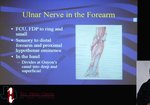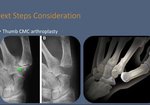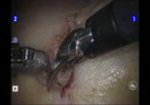Playback speed
10 seconds
0 views
March 12, 2011
The patient’s forearm must be positioned in pronation and the patient’s wrist must be in ...
read more ↘ neutral position or in slight extension (50–70). The physician places his or her semiflexed II–III fingers of one hand over the palmar surface of the distal half of the first metacarpal ( FM ), and II–III fingers of his or her opposite hand over the palmar surface of the pisotriquetral complex ( PTC ). The physician’s thumbs are placed dorsally over the lunate bone ( LB ). The examiner then simultaneously begins to press dorsally using his or her II–III fingers and volarly by the thumbs as if squeezing out the lunate bone volarly.
↖ read less
read more ↘ neutral position or in slight extension (50–70). The physician places his or her semiflexed II–III fingers of one hand over the palmar surface of the distal half of the first metacarpal ( FM ), and II–III fingers of his or her opposite hand over the palmar surface of the pisotriquetral complex ( PTC ). The physician’s thumbs are placed dorsally over the lunate bone ( LB ). The examiner then simultaneously begins to press dorsally using his or her II–III fingers and volarly by the thumbs as if squeezing out the lunate bone volarly.
↖ read less
Comments 1
Login to view comments.
Click here to Login



















